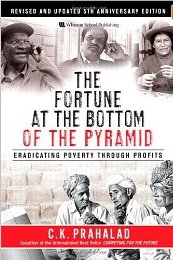 The Fortune at the Bottom of the Pyramid – Eradicating Poverty Through Profits”
The Fortune at the Bottom of the Pyramid – Eradicating Poverty Through Profits”
by C.K. Prahalad
ISBN: 978-013187729
Written in 2003/4, before the triple-bottom-line (people, planet, profit) found its way into mainstream corporate vocabulary, this book is at the same time a review of some of the success corporations had in creating business models to serve the poorest of the poor, and a primer to some of the essential success factors to do so.
The poorest of the poor are the approximately 4 billion people living on less than 1500$ a year, and depending on a specific country, often on as little as 2$ a day – hence where the term ‘Bottom’ or ‘Base’ of the Pyramid (BOP) comes from.
The author C.K. Prahalad explains how the poor, despite their evident lack of financial means, pay poverty penalties which are at least partly responsible for the prolongation of their fate, and that could remedied if the market economy reached into said communities:
- Usurious interest rates on borrowed money– 10% or more per day.
Reason: Lack of access to a professional financing sector (banks), and hence dependence on loan sharks. - High expenditures per unit of energy/electricity.
Reason: The communities are generally not connected to the national grid, and therefore rely on petrol or wood to fulfil their basic need for energy. - Difficult / inefficient /expensive access to [free] public services.
Reason: Illiteracy rate is high, and geographical distance vast, which leads to middle men being used. Additionally, inefficiency of public services requires a substantial time investment to access them (stand by/wait time). In a population chiefly living off daily wages, this effectively translates to substantial salary losses. - Limited access to reliable, objective information and direct access to the consumers of their goods.
Reason: Large geographical distances and traditional (rural) market mechanisms, which all favour middle men, remain in place. Producers only have contact with the wholesale buyer instead of a companies’ own supply chain representative. Lack of access to real time and objective market information and valuation of their goods causes them being paid bellow-market prices for their produces.
With this proposition in mind, the book explains key factors in doing successful business – read: profitably as well as with a positive social impact – with the poor. While access to working capital and quality products for the individual and the communities is at the core of many of the presented success stories, the author makes a rather surprising, but no doubt important, and valuable point throughout:
Innovating (or maybe more accurately: re-inventing) business models, product designs and production processes is absolutely key for any organisation wishing to be successful in this market segment.Let us have a look at one of the case studies in order to illustrate what the author means by “innovation”:
The Aravind Eye Hospitals were born out of one man’s bold dream: To make away with needless blindness caused by, technically, easily curable eye diseases such as cataracts. Currently (2009) there are 5 hospitals (plus 4 managed institutions not further considered here), with a total of 3590 beds, of which 2760 are free, i.e. for non-paying patients. A total of 2’313’398 outpatient visits were handled and 270’444 operations were performed (2006 numbers). Two-third of the outpatient visits and three-fourth of the operations were serviced to the poor, free of cost. In addition, through rural clinics and screening camps 2’748’216 persons were screened for potential blinding eye diseases. The system is wholly self-financed, and uses only best-of-class, new, in many cases imported medical equipment.
In the Aravind Eye Hospitals, target costing in the case of the original cataract operation is set as being around £30 per operation (assuming no complications ensued). This compares to around £200 as an average cost for treatment in a conventional Indian hospital. An operation in the Aravind system only requires 10 minutes.
And finally: At a total of more than 200’000 cases per year, each doctor carries out around 2600 operations per year (against an Indian average of around 400). Complications arise in the Aravind system in 5 out of every 10’000 patients.
In comparison, in the UK, a cataract eye operation would typically take 30 minutes. A cataract operation under the NHS costs on average £800; undertaken privately, the same operation costs in excess of £2000. A private cataract specialist carries out an average of 500 to 600 cases per year. Complications arise in 6 out of 10’000 cases.
In brief, by Western standards the Aravind Eye Hospitals perform with some margin as a best-in-class health care provider!
To sum it all up: ‘The fortune at the bottom of the pyramid’ makes a number of valid points about how and why to do business with the ‘poorest of the poor’ customers. The author has to accept the critique however, that he blissfully ignores the environmental requirements and impacts of such business activities. In sight of the sheer masses at the BOP, and with view to the fact that the vulnerable communities the author principally focuses on are the hardest affected by pollution and climate change , this is a crucial, major omission. This said, the book is written in a clear, concise language with plenty of explanatory examples, and is an interesting, time worthy read.
This book is available from your nearest book store, or online from Amazon.

